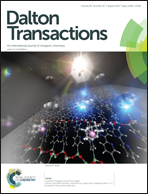Molybdenum complexes derived from the oxydianiline [(2-NH2C6H4)2O]: synthesis, characterization and ε-caprolactone ROP capability†
Abstract
The reaction of Na2MoO4 with 2,2′-oxydianiline (2-aminophenylether), (2-NH2C6H4)2O, LH4, in DME (DME = 1,2-dimethoxyethane) in the presence of Et3N and Me3SiCl afforded either the bis(imido) molybdenum(VI) complex {Mo(L)Cl2(DME)} (1), where L = (2-NC6H4)2O, or the molybdenum(V) salt [Mo(L′)Cl4][Et3NH] (2), where L′ = [(2-NH2C6H4)(2-NC6H4)O], depending on the work-up method employed. The same diamine reacted with in situ [Mo(NtBu)2Cl2(DME)] afforded a tetra-nuclear complex [Mo4Cl3(NtBu)3(OSiMe3)(μ4-O)(L)2(L′)2]·2MeCN (3·2MeCN). The crystal structures of 1, 2 and 3·2MeCN have been determined. The structure of the bis(imido) complex 1 contains two unique molecules paired up via weak π-stacking, whereas the structure of 2 contains a chelating amine/imido ligand, and is made up of discrete units of two cations and two anions which are interacting via H-bonding. The tetra-nuclear structure 3 contains four different types of distorted octahedral molybdenum centre, and a bent Me3SiO group thought to originate from the precursor synthesis. Complexes 1–3 have been screened for their ability to ring open polymerize (ROP) ε-caprolactone. For 1 and 3 (not 2), conversion rates were good (>90%) at high temperatures (100 °C) over 6–24 h, and the polymerization proceeded in a living manner.
![Graphical abstract: Molybdenum complexes derived from the oxydianiline [(2-NH2C6H4)2O]: synthesis, characterization and ε-caprolactone ROP capability](/en/Image/Get?imageInfo.ImageType=GA&imageInfo.ImageIdentifier.ManuscriptID=C5DT01799H&imageInfo.ImageIdentifier.Year=2015)

 Please wait while we load your content...
Please wait while we load your content...